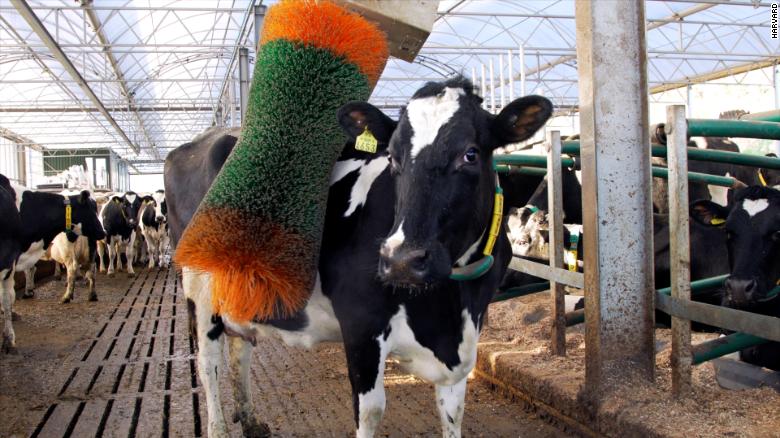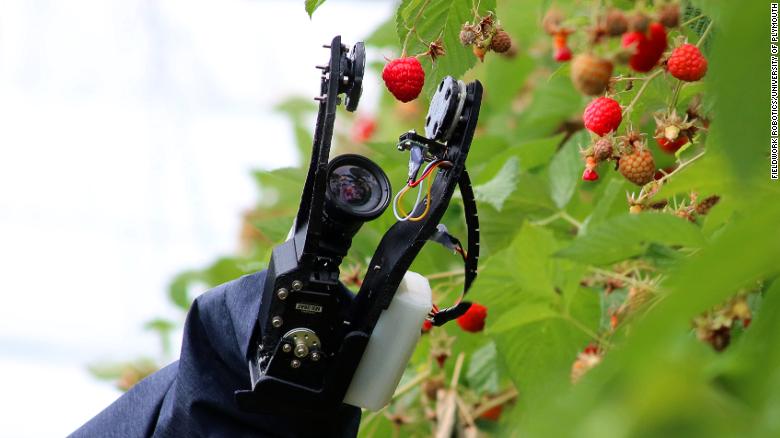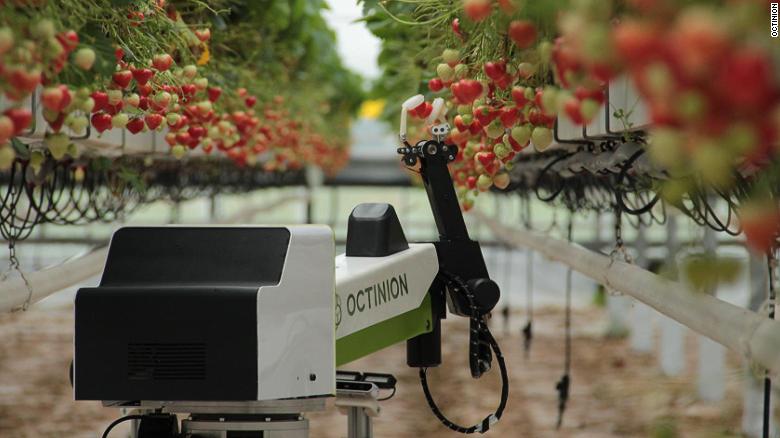But recently, technological developments and advances in machine learning have led to successful trials of more sensitive and dexterous robots, which use cameras and artificial intelligence to locate ripe fruit and handle it with care and precision.
Developed by engineers at the University of Cambridge, the Vegebot is the first robot that can identify and harvest iceberg lettuce — bringing hope to farmers that one of the most demanding crops for human pickers could finally be automated.
First, a camera scans the lettuce and, with the help of a machine learning algorithm trained on more than a thousand lettuce images, decides if it is ready for harvest. Then a second camera guides the picking cage on top of the plant without crushing it. Sensors feel when it is in the right position, and compressed air drives a blade through the stalk at a high force to get a clean cut.
Its success rate is high, with 91% of the crop accurately classified, according to a
study published in July. But the robot is still much slower than humans, taking 31 seconds on average to pick one lettuce. Researchers say this could easily be sped up by using lighter materials.
Such adjustments would need to be made if the robot was used commercially. „Our goal was to prove you can do it, and we’ve done it,“ Simon Birrell, co-author of the study, tells CNN Business. „Now it depends on somebody taking the baton and running forward,“ he says.
More mouths to feed, but less manual labor
With the world’s population expected to climb to
9.7 billion in 2050 from 7.7 billion today — meaning roughly
80 million more mouths to feed each year — agriculture is under pressure to meet rising demand for food production.
Added pressures from climate change, such as extreme weather, shrinking agricultural lands and the depletion of natural resources, make innovation and efficiency all the more urgent.
This is one reason behind the industry’s drive to develop robotics. The global market for agricultural drones and robots is projected to grow from $2.5 billion in 2018 to $23 billion in 2028, according to a report from market intelligence firm
BIS Research.
„Agriculture robots are expected to have a higher operating speed and accuracy than traditional agriculture machinery, which shall lead to significant improvements in production efficiency,“ Rakhi Tanwar, principal analyst of BIS Research, tells CNN Business.
On top of this, growers are facing a long-term labor shortage. According to the
World Bank, the share of total employment in agriculture in the world has declined from 43% in 1991 to 28% in 2018.
Tanwar says this is partly due to a lack of interest from younger generations. „The development of robotics in agriculture could lead to a massive relief to the growers who suffer from economic losses due to labor shortage,“ she says.
Robots can work all day and night, without stopping for breaks, and could be particularly useful during intense harvest periods.
„The main benefit is durability,“ says Martin Stoelen, a lecturer in robotics at the University of Plymouth and founder of Fieldwork Robotics, which has developed a raspberry-picking robot in partnership with Hall Hunter, one of the UK’s major berry growers.
Their robots, expected to go into production next year, will operate more than 20 hours a day and seven days a week during busy periods, „which human pickers obviously can’t do,“ says Stoelen.
Sustainable farming and food waste
Robots could also lead to more sustainable farming practices. They could enable growers to use less water, less fuel, and fewer pesticides, as well as producing less waste, says Tanwar.
At the moment, a field is typically harvested once, and any unripe fruits or vegetables are left to rot. Whereas, a robot could be trained to pick only ripe vegetables and, working around the clock, it could come back to the same field multiple times to pick any stragglers.
Birrell says that this will be the most important impact of robot pickers. „Right now, between a quarter and a third of food just rots in the field, and this is often because you don’t have humans ready at the right time to pick them,“ he says.
A successful example of this is the strawberry-picking robot developed by Octinion, a Belgium-based engineering startup.
The robot — which launched this year and is being used by growers in the UK and the Netherlands — is mounted on a self-driving trolley to serve table top strawberry production.
It uses 3D vision to locate the ripe berry, softly grips it with a pair of plastic pincers, and — just like a human — turns it 90 degrees to snap it from the stalk, before dropping it gently into a punnet.
„Robotics have the potential to convert the market from (being) supply-driven to demand-driven,“ says Tom Coen, CEO and founder of Octinion. „That will then help to reduce food waste and increase prices,“ he adds.
Harsh conditions
One major challenge with agricultural robots is adapting them for all-weather conditions. Farm machinery tends to be heavy-duty so that it can withstand rain, snow, mud, dust and heat.
„Building robots for agriculture is very different to building it for factories,“ says Birrell. „Until you’re out in the field, you don’t realize how robust it needs to be — it gets banged and crashed, you go over uneven surfaces, you get rained on, you get dust, you get lightning bolts.“
California-based Abundant Robotics has built an apple robot to endure the full range of farm conditions. It consists of an apple-sucking tube on a tractor-like contraption, which drives itself down an orchard row, while using computer vision to locate ripe fruit.
This spells the start of automation for orchard crops, says Dan Steere, CEO of Abundant Robotics. „Automation has steadily improved agricultural productivity for centuries,“ he says. „[We] have missed out on much of those benefits until now.“






